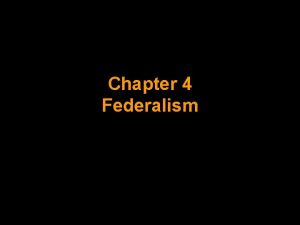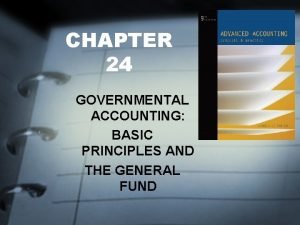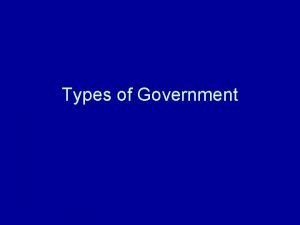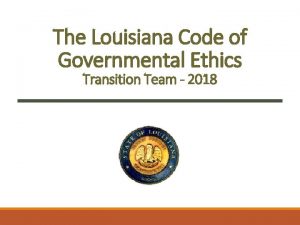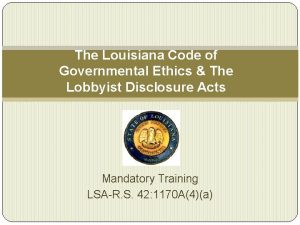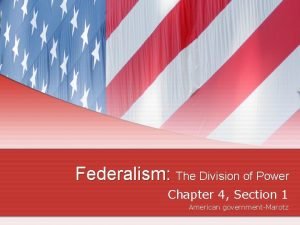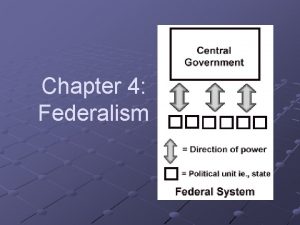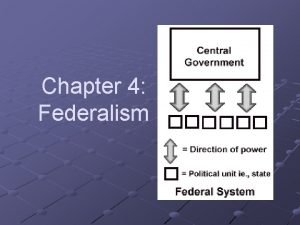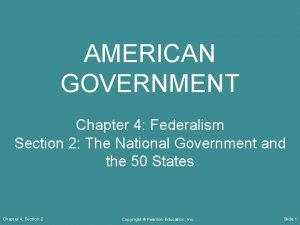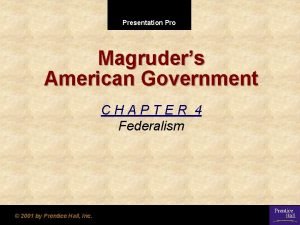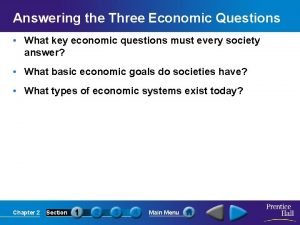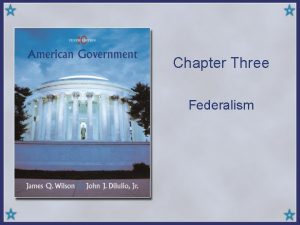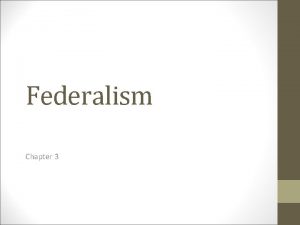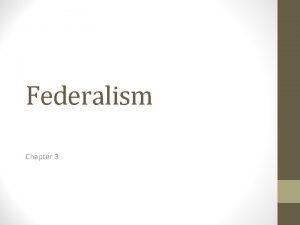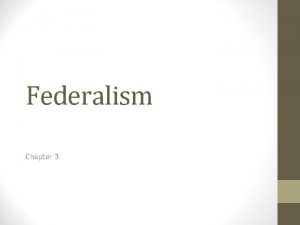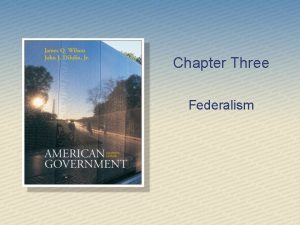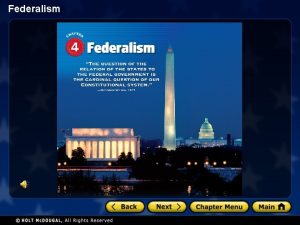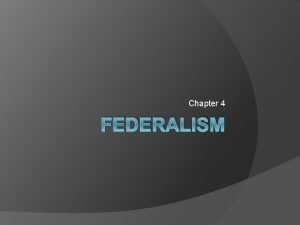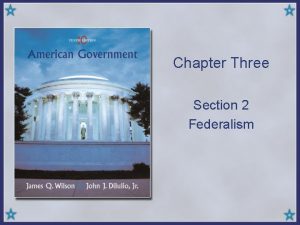Chapter Three Section 1 Federalism Governmental Structure Federalism















- Slides: 15

Chapter Three Section 1 Federalism

Governmental Structure • Federalism: a political system where local government units can make final decisions regarding some governmental activities and whose existence is protected • Unitary System: local governments are subservient to the national government Copyright © Houghton Mifflin Company. All rights reserved. 2

Chapter Three Section 2 Federalism

Federalism Over Time • Dual federalism (Dual Sovereignty? ): Both national and state governments are supreme in their own spheres, which should be kept separate • Hard to make distinctions between state and federal spheres; distinctions between them were blurred • The Supreme Court has become the ultimate final judge of the balance between states’ rights and the national government Copyright © Houghton Mifflin Company. All rights reserved. 4

Mc. Culloch v. Maryland 1819 • John Marshall – Chief Justice • Could Congress charter a corporation? Yes, even though this power is not explicitly in the Constitution (Necessary and Proper Clause) • Could states tax the national bank? No, because Federal government derives power from PEOPLE NOT THE STATES, and “the power to tax is the power to destroy” • Enumerated powers could be ‘interpreted’: bank power found in money/tax/borrow powers • SUPREME COURT GETS TO INTERPRET!! Copyright © Houghton Mifflin Company. All rights reserved. 5

NULLIFICATION The legal theory that a U. S. State has the right to nullify, or invalidate, any federal law which that state has deemed unconstitutional. Copyright © Houghton Mifflin Company. All rights reserved. 6

State Sovereignty • State constitutions can be more detailed • States’ constitutions may provide for direct democracy rather than a Republic – Initiative – Referendum – Recall • Police Power – can do what is not prohibited by the Constitution or preempted by federal policy, and that is consistent with its own constitution – are also responsible for public education, law enforcement, criminal justice, health, roads, public welfare, and use of public lands Copyright © Houghton Mifflin Company. All rights reserved. 7

Municipalities • Cities, towns, counties, and districts have no Constitutional protections. They exist at the pleasure of the state government. – Municipal Corporations • Dillon’s Rule: Express, Implied, or Essential – General Act Charter – Special Act Charter • Home-Rule Charter Copyright © Houghton Mifflin Company. All rights reserved. 8

Chapter Three Section 3 Federalism

Federal Aid and Federal Control • • Categorical grants Mandates Block Grants Revenue Sharing Copyright © Houghton Mifflin Company. All rights reserved. 10

Federal Aid and Federal Control • Categorical grants for specific purposes defined by federal law; often require local matching funds (90/10) – Conditions of aid: tell state governments what they must do if they wish to receive grant money Copyright © Houghton Mifflin Company. All rights reserved. 11

Federal Aid and Federal Control • Mandates: federal rules that states or localities must obey, generally have little or nothing to do with federal aid – Environmental – Civil Rights (Voting Rights Act, ADA) • Race, religion, gender, origin, disability – Educational? (NCLB) • Legislative or Judicial • Recent court cases have limited mandates Copyright © Houghton Mifflin Company. All rights reserved. 12

Grants in Aid Required broad congressional coalitions with wide dispersion of funds, because every state had incentive to seek grant money • Leads to – Special Interest Effect – Intergovernmental Lobbying – Pork barrel spending • earmarks – Log rolling Copyright © Houghton Mifflin Company. All rights reserved. 13

Devolution • Devolution initiatives returned program management to the states, with some federal guidelines, but there is no guarantee of federal support • Devolution proponents harbor a deep-seated ideological mistrust of federal government and believe that state governments are more responsive to the people • Deficit politics encouraged devolution • Devolution is supported by public opinion, but the strength of that support is uncertain Copyright © Houghton Mifflin Company. All rights reserved. 14

Block Grants and Revenue Sharing • Block grants (sometimes called special revenue sharing or broad-based aid) devoted to general purposes with few restrictions—states preferred block to categorical grants – Operational, Capital, and Entitlement – Cities (CDBG), Law Enforcement (LEAA), Social Programs (CETA): Unemployment and Welfare (AFDC) • Revenue sharing (GRS) requires no matching funds and can be spent on almost any governmental purpose. – Determined by statistical formula Copyright © Houghton Mifflin Company. All rights reserved. 15
 Chapter 4 section 1 federalism powers divided
Chapter 4 section 1 federalism powers divided Federalism the division of power chapter 4 section 1
Federalism the division of power chapter 4 section 1 Vision mission and objectives of ngo
Vision mission and objectives of ngo 13 basic governmental accounting principles
13 basic governmental accounting principles Governmental systems
Governmental systems Louisiana code of governmental ethics
Louisiana code of governmental ethics Louisiana code of ethics
Louisiana code of ethics Role of ngos
Role of ngos Non-governmental health agencies are funded primarily by
Non-governmental health agencies are funded primarily by Section quiz 4-3 developing federalism
Section quiz 4-3 developing federalism Chapter 4 federalism the division of power
Chapter 4 federalism the division of power Chapter 4 federalism
Chapter 4 federalism Chapter 4 federalism
Chapter 4 federalism Chapter 4 federalism answer key
Chapter 4 federalism answer key Chapter 4 federalism
Chapter 4 federalism Chapter 2 section 1 answering the three economic questions
Chapter 2 section 1 answering the three economic questions

